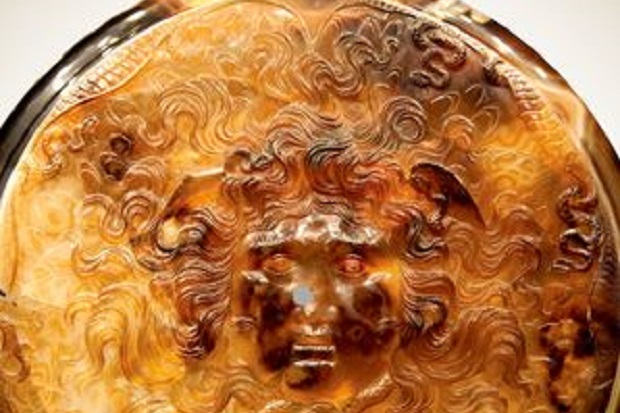The stone called sardonyx looks a lot more fragile than it actually is. It’s luminous like glass, but hard like steel, which explains why so much of it has survived from ancient times.
Fame being a relative word, one might describe Medusa’s Gaze: The Extraordinary Journey of the Tazza Farnese by Marina Belozerskaya as a biography of the most famous sardonyx object in the world, the Tazza Farnese, an ancient libation bowl made to hold offerings to the gods.
At least one of the many people who inherited it aimed to change that function. Around the time Romanos II, son of Constantine VII, was ruler over Byzantium, someone drilled through its middle to transform it into a Christian chalice. But try as one might, even a hole could not conceal the fact that the Tazza started life as a thoroughly pagan objet d’art. The alteration meant that the Gorgon Medusa that adorns its outer façade now had an enormous nose piercing.
It’s still not clear who the people are that adorn the inside of the bowl, but the goddess Isis and a personification of the Nile are as good a guess as any. The suggestion that the Tazza Farnese was made at the Ptolemaic court, possibly under Cleopatra, who likened herself to Isis, is in fact a lot more convincing than past theories which have promoted a Roman origin.
That’s not to say that the Romans did not eye the bowl with wonder. Belozerskaya’s theory that Octavian, the future Emperor Augustus, took it as booty following his victory over Antony and Cleopatra at Actium is particularly compelling. As the great historian of the emperors Suetonius described, Octavian was eager for Alexandrian spoils to fund his own expenses. Perhaps the Tazza was simply considered too beautiful to melt down. If, as Belozerskaya suggests, the bowl was among the objects Constantine imported to his new capital from Rome, he perhaps did so in the knowledge that it had belonged to Augustus, whose spirit he longed to revive.
One of the most surprising – and the first confirmed – stop-offs on the Tazza’s journey was with Tamerlane, the fearsome Mongol warlord. How he acquired the object remains a mystery, but a fine drawing of the bowl interior from his court perhaps provides a clue as to its value as art, not just wealth, even in these oppressive surroundings.
Given its various manifestations and meanings through time, one cannot help but wonder how the bowl’s various owners referred to it on a daily basis. It was only in the Renaissance, after it passed from Margaret of Parma into the Farnese family through her second husband, that it acquired its modern name. So it is that we cannot know whether the ‘large onyx dish’ purchased by Frederick II, Holy Roman Emperor, was the Tazza Farnese or a comparable object.
Medusa’s Gaze is less a history of art than glorious sweep from one type of court to another. Though a specialist book, it is always accessible. As much as one remains eager to know which path the Tazza Farnese actually followed, it is the author’s unapologetic acceptance of the uncertainty of its provenance that makes Medusa’s Gaze so rich a history.
Medusa’s Gaze is published by OUP, £14.99






Comments